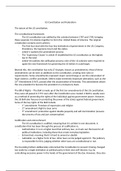US Constitution and Federalism
The nature of the US constitution;
The constitutional framework;
The US constitution was ratified by the colonies between 1787 and 1790, bringing
these separate 13 colonies together to form the: United States of America. The original
constitution contains seven articles;
- The first four deal with the four key institutions of government in the US; Congress,
Presidency, the Supreme Court and the states.
- Article V outlines the amendment process
- The ‘Supremacy Clause’ in article VI established the US constitution as the highest
law in the land.
- Article VII outlines the ratification process; nine of the 13 colonies were required to
agree the new framework for governing the US before it could begin.
Beyond this, the constitution has only 27 changes, known as amendments. Most of these
amendments can be seen as additions to the constitution, creating new rules or
requirements. Some amendments represent major social change or are the end product of
huge violence, conflict and death. Others make extremely important alterations, such as the
25th Amendment (1967), passed after the assassination of Kennedy. This amendment allows
the vice president to become the president on a temporary basis.
The Bill of Rights – The BoR is made up of the first ten amendments of the US constitution.
They were all passed in 1791 soon after the Constitution was created. A BoR is usually seen
as a method of protecting the rights of the individual against government power. However,
the US BoR also focuses on protecting the power of the states against federal government.
Some of the key rights of the BoR include;
- 1st amendment: Freedom of expression and religion
- 2nd amendment: Right to bear arms
- 5th amendment: protection against double jeopardy and self-incrimination (ensures
due process of law and just compensation)
Codification and entrenchment;
The US constitution is codified, meaning that it is written in one document. A
constitution that has been through the process of codification is;
- Authoritative: it is on a higher level that ordinary law, so it sets out the basis for all
political institutions, including those that create everyday legislation.
- Entrenched: meaning that it is hard to amend or abolish
- Judiciable: as a higher form of law, other laws can be judged against it. The judiciary
is responsible for this, judging whether other laws are constitutional or not.
The Founding Fathers deliberately entrenched the Constitution to prevent it being changed
too easily by a single institution or political party in their own self-interest. E.g. by
centralising excessive power in the hands of the government of the day. However, they also
, knew that there would need be some mechanism for changing the constitution to meet the
changing needs of society. This amendment process is set out in Article V.
Vagueness;
Given that the constitution is the main guide for US politics, it is short. There are
manly clearly enumerated powers (powers explicitly stated, such as Article 1, Section 8
which provides a list of congressional powers), but the constitution is often unclear. This is
partly because it is compromise between often disagreeing founding fathers, but partly
because there was a deliberate decision to allow for the constitution to evolve. However,
this lack of clarity means that there is often significant disagreement over its meaning. The
constitution has many enumerated powers. However, many implied powers have been
found in the constitution too (powers that are not expressly written down in the
constitution but are needed to perform an enumerated power or are suggested by the
wording)
Enumerated Powers Implied Powers
Powers held by congress; Powers held by congress;
- Borrowing money on behalf of the - The necessary and proper clause
US - Interstate clause
- Declaration of war
- Establishing post offices
Powers held by the President; Powers held by the President;
- Grants pardons - Commander in chief of the Armed
- Vetoes legislation Forces
- Nominates cabinet members,
ambassadors and the judiciary
Powers held by the courts; Powers held by the courts;
- Rule on cases arising under the - The power of judicial review
Constitution, the Laws of the US and
treaties.
The ‘necessary and proper clause’:
- Article 1, Section 8 of the constitution states that Congress has the power ‘to make
all laws which shall be necessary and proper for carrying into execution the
foregoing powers’. This clause allows congress to stretch its powers. It has been a
source of great controversy, being used to justify major expansion of the power of
federal government. E.g in. McCulloch v Maryland (1819), the Supreme Court tested
the necessary and proper clause and ruled that Congress has the power to create a
national bank, even though the right to create a bank is not explicitly stated in the
constitution. It gave a broad interpretation using implied powers to allow Congress
to act. The interstate commerce clause has also been described as elastic as it has
been used to justify the expansion of federal power.
This vagueness could be seen as a considerable advantage. It has arguably allowed the
constitution to survive for such a long time as its meaning can be adapted without the need
of formal amendments. A more detailed constitution would perhaps have been harder to





